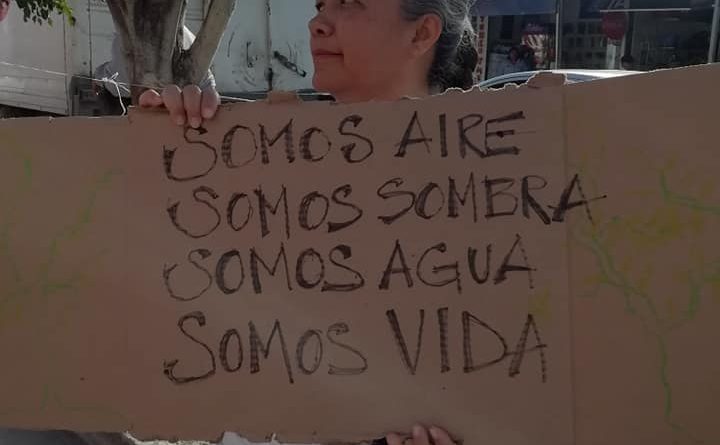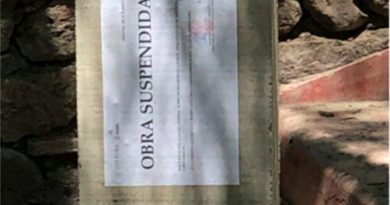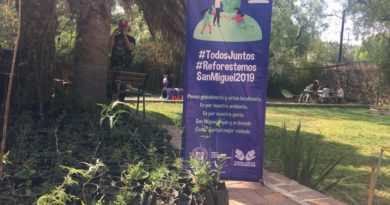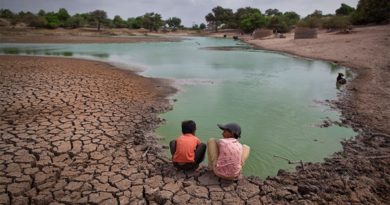How green is San Miguel de Allende? Not green enough…
As we write this, Sanmiguelenses are protesting the removal of 33 fiscus trees along Avenida Guadalupe. There are many arguments for and against the project, which we will discuss later, but we all agree that San Miguel de Allende cannot afford to lose any more trees.
Green areas are essential to the well-being of every city in the world. Parks, playgrounds and gardens are vital for mental and physical health. Access to green areas is correlated with lower obesity and even reduction in crime. In this age of global warming, trees and vegetation have taken on a more urgent role of temperature moderation and rainwater absorption. They prevent soil erosion, control dust, carbon and pollution, and provide habitat for wild animals and birds.
However, if you look at a satellite map of San Miguel de Allende, you will see a blanket of cement and stone, especially in the newer developments.
We have been trying to establish the exact percentage of green spaces in San Miguel’s urban area. The responses have ranged from 2.8% to a little over 12%. The discrepancies may arise from the definitions of what is a green space and whether it includes only publicly accessible parks or private gardens as well. Let’s accept the higher number of 12%. How does that compare with the most livable cities in the world? Very poorly.
There are many factors that make a city livable but one thing they all have in common is abundant, easily accessible green space. Take Vienna for example, ranked as the world’s most livable city. Over 51% of its urban area is green space. That’s 120 m2 for every resident. Or Vancouver where over 92% of residents live within a five-minute walk of a green space. Even Hong Kong and Singapore, both tiny island nations where land is at a premium have 40% and 47% green spaces respectively.
Not only do we have inadequate green spaces in San Miguel, the few well maintained and functioning parks are in the most expensive areas of town. This makes them inconvenient or inaccessible to those from the poorer colonias and communities, reinforcing class and socioeconomic division. Compare the equipment and maintenance of say the Guadiana park with the parks in colonias such as Barrio La Palmita or La Luz.
Recently, we met with Francisco Peyret, Director of Medio Ambiente y Sustentabilidad, in the current municipal administration, to discuss these issues and hear his plans to address them. Director Peyret told us that he has made the restoration of the 80 parks within the urban area a high priority. He is trying to get neighbours involved in the maintenance of their local parks, something we can all participate in. The Direccion of Medio Ambiente y Sustentabilidad is also actively working on the urgently needed restoration of the arroyos, especially in areas where their degradation and contamination are hazardous to the health of residents, such as around the San Juan de Dios market. Throughout the municipality, the Direccion is involved in ongoing reforestation and watershed restoration, including Henry Miller’s project in Doña Juana which we have already reported on. Seven more similar projects are planned for next year.
We asked Peyret about the situation of the 33 fiscus. He explained that when the city took on the project of improving the health, safety and livability around the Avenida Guadalupe, they were forced to address the row of fiscus planted 20 years ago along the center of the Avenida. Fiscus, while lovely, are not native to this area. They require a lot of water. These particular trees were also planted far too close together and in an unfortunate strip that impedes both pedestrian and vehicular traffic in an extremely busy area. It was decided to transplant the trees to a more suitable location. When the improvements to the area are completed, the same number of trees will be planted along the Avenida, but instead of fiscuses or other exotics, they will choose species native to the area.
We agree that the Avenida Guadalupe is a mess – unhealthy, over-crowded and unsafe – and are pleased to see that the government is improving the area. We also agree that the fiscuses were a poor choice.
However, we are extremely concerned about the loss of much needed biomass. Any new trees will take years to grow to the size of those that are already there and thus years to provide the same amount of shade and absorb an equal amount of carbon and pollution.
We also question the process of transplantation. It is not a simple exercise and it is unclear whether the government has access to the level of expertise required to successfully transplant mature trees. The fact that they are considering doing so at the time of year when trees are most vulnerable, suggests that they do not.
Our major concern though is a lack of a long-term sustainable plan for greening the city. How do we know that in another 15 or 20 years another administration won’t come up with a new plan and remove whatever trees this administration plants? Trees are complicated living systems that live for centuries. Tearing them up every time an administration wants to leave their mark is extremely short-sighted and irresponsible. Protest is important and every tree, like every living thing, deserves to live and flourish. But focussing on individual trees or parks isn’t sustainable. We need to work on restoring the entire ecosystem after centuries of abuse.
We at the Observatorio are encouraged by many of Director Peyret’s plans and his enthusiasm We will continue to watch closely to see how those plans come to fruition and we encourage all residents to do the same. What we plant today will affect the lives of Sanmiguelenses for generations to come.




